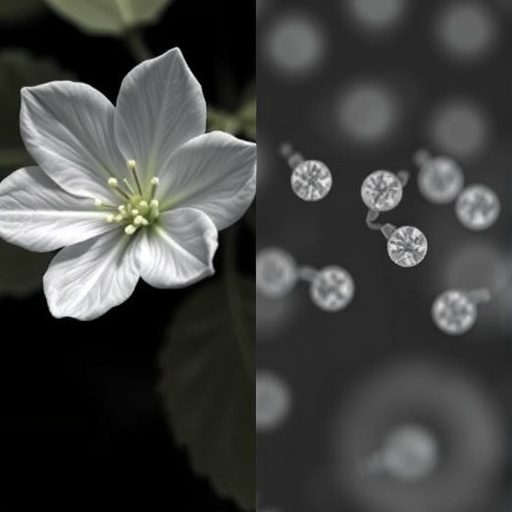In an innovative stride towards sustainable nanotechnology, researchers have explored the biogenic synthesis of magnesium oxide (MgO) nanoparticles using two distinct plant biomasses: Bauhinia variegata and Lawsonia inermis. This comparative study highlights not only the intricate processes involved in nanoparticle formation but also delves into the structural attributes and potential pharmaceutical applications of the synthesized nanoparticles, marking a significant step forward in both material science and environmental sustainability.
Nanoparticles, with their unique physical and chemical properties, have garnered immense attention across various fields, including medicine, electronics, and environmental science. The ability to create these nanoparticles through environmentally friendly processes has become a focal point for researchers aiming to minimize the ecological footprint of traditional synthesis methods, which often utilize toxic chemicals and generate hazardous waste. This recent study exemplifies this shift by harnessing the natural resources offered by Bauhinia variegata and Lawsonia inermis.
Bauhinia variegata, commonly known as the orchid tree, is indigenous to tropical and subtropical regions, known for its striking flowers and potential medicinal properties. Lawsonia inermis, or henna, has a storied history of use in traditional medicine and body art. The choice of these two biomasses is not merely aesthetic; both plants are rich in phytochemicals that can strongly influence the nucleation and growth of nanoparticles. Understanding how these constituents interact during nanoparticle synthesis is a critical component of the research.
The synthesis process begins with the extraction of phytochemicals from the biomass, which serve as reducing and stabilizing agents. In this study, the researchers efficiently harnessed the bioactive compounds present in both plants, effectively replacing harmful chemicals typically used in nanoparticle synthesis. This transition to greener methods not only aligns with global sustainability efforts but also opens new avenues for the application of these nanoparticles in various fields.
Upon synthesizing MgO nanoparticles, the researchers meticulously characterized their structural attributes using advanced techniques such as X-ray diffraction (XRD), scanning electron microscopy (SEM), and transmission electron microscopy (TEM). These characterization techniques revealed critical data on the size, morphology, and crystallinity of the nanoparticles produced from each biomass, providing insights into their potential efficiency and versatility in application.
One significant discovery from this comparative analysis was the variation in the size and shape of the nanoparticles synthesized from Bauhinia variegata versus those derived from Lawsonia inermis. The study found that the specific phytochemicals released during the synthesis process lead to distinct structural features, which may influence their suitability for various applications, particularly in the pharmaceutical realm. The implications of these findings are profound, as the success of nanoparticle applications in medicine often hinges on their size, shape, and surface characteristics.
Pharmaceutical applications of MgO nanoparticles are wide-ranging. They can act as carriers for drug delivery systems, facilitate targeted therapy, and possess inherent antimicrobial properties, making them suitable for various medical applications. The study emphasizes the potential of these biogenic nanoparticles in addressing significant challenges in pharmaceuticals, such as improving the solubility of poorly soluble drugs and reducing side effects.
Aside from their medicinal uses, the synthesized MgO nanoparticles could also have implications in environmental science. With increasing concerns over pollution and waste management, biogenic nanoparticles present an opportunity to develop eco-friendly materials that can aid in water purification and soil remediation efforts. The researchers suggest that the inherent properties of these nanoparticles, rooted in their green synthesis methods, may enhance their effectiveness in such environmental applications.
In addition to the environmental benefits, the economic feasibility of utilizing biomass for nanoparticle synthesis is noteworthy. The low-cost and naturally abundant nature of Bauhinia variegata and Lawsonia inermis set a precedent for a cost-effective approach to nanoparticle production. This process not only supports the local economy and encourages the cultivation of these plants but also aligns with the principles of waste valorization—repurposing organic waste into valuable materials.
As the research community increasingly seeks sustainable alternatives in nanotechnology, the work presented in this study contributes to the growing body of literature advocating for green methodologies. The potential benefits of integrating plant biomasses into nanoparticle synthesis processes could revolutionize the field by offering safer, more efficient, and environmentally friendly approaches.
The researchers acknowledge that while the initial findings are promising, further studies are necessary to fully elucidate the mechanisms behind the synthesis process and the interactions between phytochemicals and metal ions. Continuous exploration in this area will be essential to optimize the production processes and expand the range of applications for these biogenic MgO nanoparticles.
In conclusion, this groundbreaking research opens new pathways in the synthesis of nanoparticles through biogenic methods, highlighting the remarkable capabilities of natural biomasses. The ability to employ Bauhinia variegata and Lawsonia inermis not only aligns with sustainable practices but also showcases the potential for these synthesized MgO nanoparticles to make meaningful impacts in pharmaceutical and environmental applications. As the journey into biogenic nanotechnology continues, the principles of sustainability and innovation remain at the forefront, offering hope for a greener future.
Subject of Research: Biogenic synthesis of magnesium oxide nanoparticles using Bauhinia variegata and Lawsonia inermis.
Article Title: Utilization of Two Biomasses from Bauhinia variegata and Lawsonia inermis for Biogenic Synthesis of MgO Nanoparticles: A Comparative Study on Structural Attributes and Pharmaceutical Applications.
Article References:
Sajid, A., Zahid, J., Sajid, A. et al. Utilization of Two Biomasses from Bauhinia variegata and Lawsonia inermis for Biogenic Synthesis of MgO Nanoparticles: A Comparative Study on Structural Attributes and Pharmaceutical Applications. Waste Biomass Valor (2025). https://doi.org/10.1007/s12649-025-03285-1
Image Credits: AI Generated
DOI:
Keywords: Nanoparticles, Magensium Oxide, Sustainable Synthesis, Bauhinia variegata, Lawsonia inermis, Biogenic Methods, Pharmaceutical Applications, Environmental Science.
Tags: Bauhinia variegata medicinal propertiesbiogenic synthesis of magnesium oxide nanoparticlescomparative study of plant-based nanoparticlesecological impact of nanoparticle synthesisenvironmentally friendly nanoparticle productiongreen chemistry in nanoparticle formationLawsonia inermis phytochemicalsnanotechnology in environmental sustainabilitypharmaceutical applications of MgO nanoparticlessustainable nanotechnology innovationstraditional medicine and nanotechnologyunique properties of MgO nanoparticles





